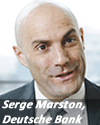New interest rate swap (IRS) futures are failing to gain traction despite the lower margin incentive, according to Serge Marston, managing director, eCommerce sales, at Deutsche Bank.
Although a number of exchanges are now offering swap futures – which
benefit from trading on exchanges and behave like an OTC instrument – the
products weren’t attracting widespread demand, Marston told the FIX EMEA
conference in London.
“In the interest swap market, I don’t think you’ll see huge amounts of change
because of the product itself,” he said. “It’s a custom-built product and even
though it offers preferential margin loss offsets on alternative products, you
still haven’t seen an explosion in volume.”
Marston compared the traditional split between OTC and listed instruments with the PC and mobile phone markets. “The iPad sits between the two. There was no market, but it was phenomenally successful. Are any of these new products an iPad? I haven’t seen it – I’m not convinced yet,” he said.
New IRS futures products are entering the market, as a result of new rules under the European market infrastructure regulation and the US Dodd-Frank, which requires OTC derivatives to be traded on exchange-like venues, known as swap executing facilities (SEFs) in the US, and cleared through central counterparties.
In the US, the cost of clearing swap futures is lower compared to SEF-traded swaps, as regulators consider it less risky, and thus the minimum margin to clear is five days of possible losses for swaps, and only one or two days for swaps futures.
In response, venue operators such as the CME Group, InterContinental Exchange and Eris Exchange have launched interest rate swap futures contracts. According to Eris Exchange there is demand, as it recorded an increase of 400% from 20,000 contracts in January 2012 to 100,000 in January 2014.
However, Marston said he saw more uptake potential for credit default swaps (CDSs), which was “more akin to an equity evolution”.
“It’s a standardised product and I think there is likely to be change in how they connect and how they execute,” he said.
“It’s only a week since the launch of SEFs and we’re starting to hear about new entrants in this space.”
The IntercontinentalExchange (ICE), alongside financial information provider Markit, have already been offering exchange-traded futures and options contracts based on corporate CDS indices since October 2012.
Painful process
In the US, mandatory trading of IRS on SEFs started on 18 February and for CDSs on 26 February. The volume of IRSs traded on SEFs dropped in the first week, but last week returned to near normal.
Stephane Malrait, global head of eCommerce, Societe Generale, who also spoke at the FIX conference, said swap market participants weren’t ready before the MAT deadline, as 80% of the market still traded by voice.
There is a “big opportunity” for European regulators to understand what went well and what can be improved in the consultation and implementation of the trading regulation.
“US regulators have implemented new requirements with very short deadlines. It was very challenging for the industry to go live in the end and for the banks to get ready for the regulation from a technology point of view but this was achieved,” he said.
“The European Securities and Markets Authority (ESMA) can learn a lot from the US by making sure what they write in the rules and how ESMA implements those rules makes sense.”
